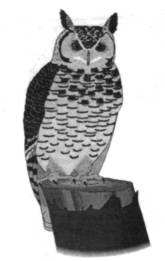|
Heard Any Good Hoots This Winter?
| This month, if you hear a hooting sound at dawn or dusk, or on a night with a full moon, you are probably listening to the mating ritual of the Great Horned Owl. This owl's call is the classic HOO!hu-hu-hu
HOO-HOO! Unlike most birds, which mate in spring, Great Horned Owls make the most of our long winter nights. It is easier for owls to hunt at this time of year, and during the month-long incubation period the male must provide food for the female as well as himself. The increased hours of darkness give him more time for hunting, and bare winter landscapes make it relatively easy to locate prey. Owls eyes are fixed in their sockets, but they can swivel their heads 270 degrees from one side to the other. Their eyes are packed with light-sensitive rod cells that give them remarkable night vision.
Also, because many raptors fly south for the winter, there is less competition for the small mammals owls prefer to eat. The Great Horned Owl is the most aggressive and powerful owl in North America. |
 |
By the time the owlets begin to venture from their nest (at about five weeks old), spring is well under way. Young animals appear, providing an increased food supply for the owls. In fact, this is probably the main reason Great Horned Owls nest during the winter: their timing ensures that the period when the food needs of their young are greatest coincides with the resurgence of animal populations. As the young owls age, they hone their hunting skills on young, inexperienced mammals. By midsummer, they disperse to establish their own territories as the "fiercest hunters of the forest."
Previous
Contents Next
|

